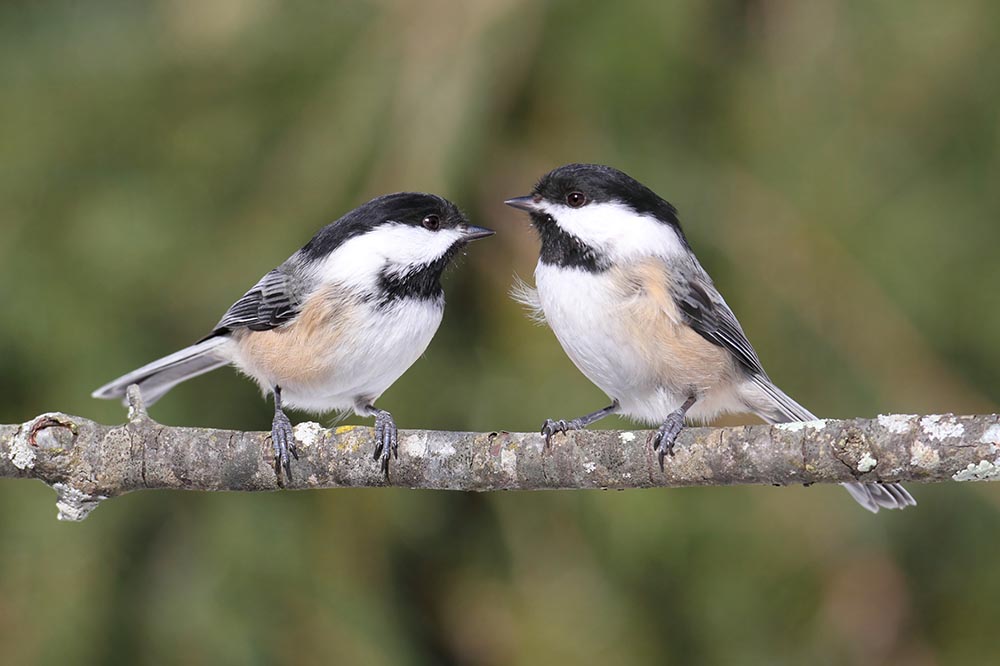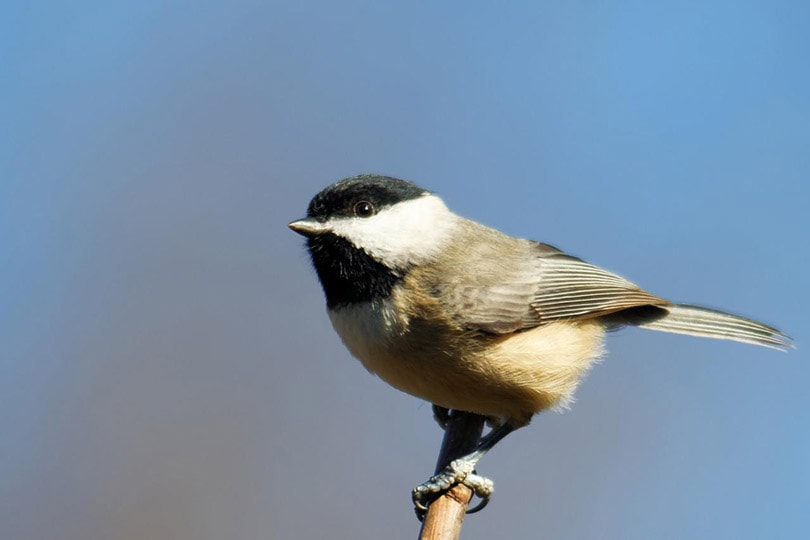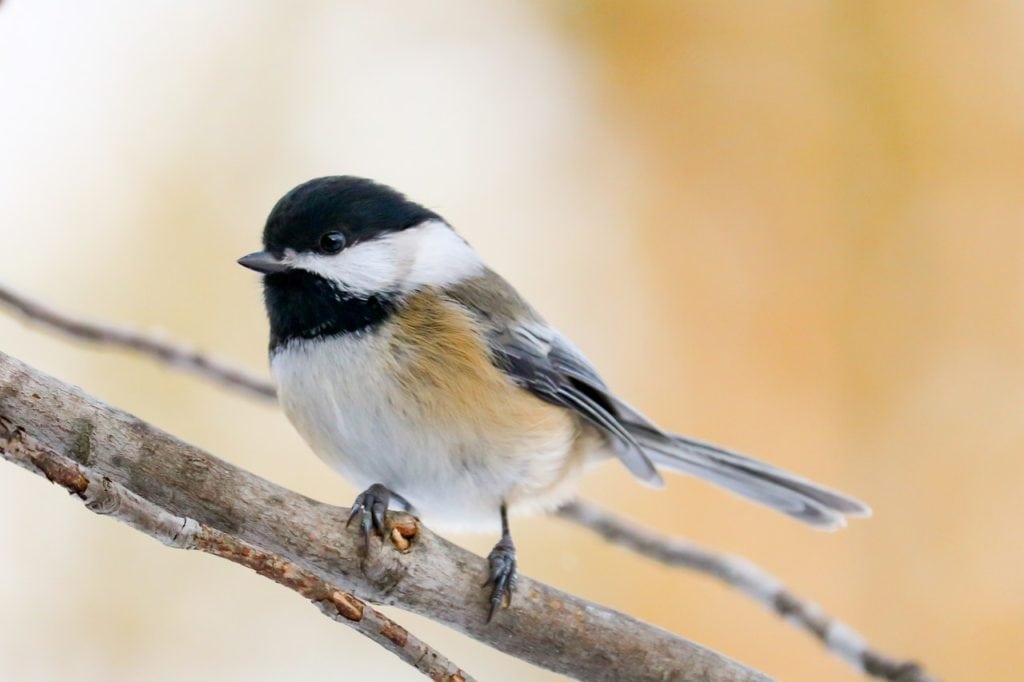Black-Capped Chickadee: Field Guide, Pictures, Habitat & Info
Last Updated on

The Black-Capped Chickadee is a small but easy-to-identify bird found throughout the northern United States. They are easy to find and easy to attract to your feeder. If you want to learn more about these amazing birds, keep reading while we discuss their range, habitat, diet, and more to help you be better informed.

Quick Facts About the Black-Capped Chickadee
| Habitat: | Forest, parks, backyards |
| Diet: | Insects, berries, seeds |
| Behavior: | Communal |
| Nesting: | Nest boxes, moss, bark, animal fur |
| Conservation: | Least concern |
| Scientific name: | Poecile atricapillus |
| Lifespan: | 2.5 years |
Black-Capped Chickadee General Description
As their name suggests, the Black-Capped Chickadee has a black cap and bib. The sides of their face are white, as is their upper chest. The back and tail are grey and the belly is rusty brown. The male and female have a similar appearance, though the male is slightly larger. They’re usually 5–6 inches long, with a wingspan of 6–8 inches.

Black-Capped Chickadee Range, Habitat, Behavior, Diet & Nesting
Range
The Black-Capped Chickadee has a wide range that stretches east to west across the United States, up into Canada, and even into Alaska. They tend to stay in the same area all year, even in the winter.
Habitat
The Black-Capped Chickadee is a widespread bird comfortable in many different environments, but they especially like forests, thickets, parks, and backyards. You will often see them along the edge of a group of trees.
Behavior
The Black-Capped Chickadee likes to form a small flock to help fend off predators and prepare for the winter. They are most active during the day and can be quite acrobatic as they hunt for and collect food. The hierarchy favors older birds over younger ones and males over females. During the winter, the birds also form flocks with other birds, like Warblers and Woodpeckers, but the flocks break up in the spring.
Diet
The Black-Capped Chickadee is primarily an insectivore that eats spiders, snails, caterpillars, and small insects. However, when winter kicks in, they switch to eating seeds and berries. They also tend to store the seeds during the winter so they can find them when needed, and if the harvest is bad, they will migrate slightly south.
Nesting
High-ranking birds mate, have access to the best resources, and often have better nests than low-ranking birds. They usually build their nests in a hole in a tree and will even use those created by Woodpeckers. The female builds the nest using coarse material, like moss and bark strips, before lining it with animal fur and other soft materials. She will lay six to eight eggs that hatch in about 2 weeks. The chicks can begin gathering food quickly after hatching, but the parents will continue to feed them for several weeks.

How to Find the Black-Capped Chickadee: Birdwatching Tips
What to Listen For
The Black-Capped Chickadee can make at least 15 different sounds to communicate with other birds. The most common one sounds like a repeating “chickadee-dee-dee-dee,” a call that they often make when they locate food.
What to Look For
Look for the black cap and white cheeks during the day, especially in the early morning when these birds are looking for food. The closer to winter it is, the more of them you will likely see congregating.
When to Look
Since these birds don’t migrate unless they can’t find food, you can look for them any time of the year. In early spring, you will see them busy building their nests. Then, they will spend time feeding the young before they begin storing food and creating larger flocks to prepare for winter.

Attracting the Black-Capped Chickadee to Your Backyard: Tips & Tricks
- The Black-Capped Chickadee is easy to attract to your yard with suet, sunflower seeds, and peanuts.
- The Black-Capped Chickadee will visit hanging feeders and window feeders.
- Alder, Birch, and Willow trees are popular nesting spots, so adding one or more to your property can be enticing for them.
- A nest box is a great way to invite a breeding pair to your property, especially if you add sawdust or wood shavings.
Black-Capped Chickadee Conservation: Is This Bird Threatened?
The Black-Capped Chickadee is the most widespread type of chickadee and has a large range, so the IUCN classifies the Black-Capped Chickadee as least concern.

Conclusion
The Black-Capped Chickadee is an attractive bird that you can find across the United States. It’s active during the day and quite acrobatic and has an easy-to-identify black cap and a white face. They are easy to attract to your property by placing feeders in the yard, and they will even use a nesting box, so you can watch them raise their young.
Featured Image Credit: Steve Byland, Shutterstock
Table of Contents
- Quick Facts About the Black-Capped Chickadee
- Black-Capped Chickadee General Description
- Black-Capped Chickadee Range, Habitat, Behavior, Diet & Nesting
- How to Find the Black-Capped Chickadee: Birdwatching Tips
- Attracting the Black-Capped Chickadee to Your Backyard: Tips & Tricks
- Black-Capped Chickadee Conservation: Is This Bird Threatened?
- Conclusion
About the Author Ed Malaker
Ed Malaker is a veteran writer who contributes to a wide range of blogs covering information on computer programming, pets, birding, tools, fitness, guitars, and optics. Outside of writing, Ed is often found working in the garden or performing DIY projects in the house. Ed is also a musician, spending his time composing music for independent films or helping people repair their guitars.
Related Articles:
10 Types of Hummingbirds in Arkansas (With Pictures)
8 Types of Hummingbirds in Nebraska (With Pictures)
5 Types of Hummingbirds in Idaho (With Pictures)
3 Types of Hummingbirds in Mississippi (With Pictures)
8 Types of Hummingbirds in Kansas (With Pictures)
5 Types of Hummingbirds in West Virginia (With Pictures)
5 Types of Hummingbirds in Ohio (With Pictures)
Where Do Nuthatches Nest? Nuthatch Nesting Habits Explained
